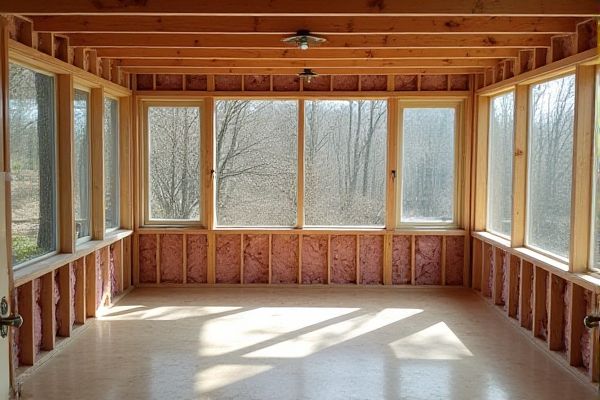
Sunroom insulation significantly enhances energy efficiency, maintaining comfortable temperatures year-round and reducing utility costs compared to no insulation, which often leads to heat loss in winter and overheating in summer. Explore the rest of this article to understand how proper insulation can transform your sunroom experience.
Table of Comparison
| Feature | Sunroom with Insulation | Sunroom without Insulation |
|---|---|---|
| Energy Efficiency | Reduces heat loss and gain, lowers energy bills | High heat transfer, increased energy costs |
| Comfort | Maintains stable indoor temperature year-round | Temperature fluctuates with outdoor weather |
| Noise Reduction | Helps reduce external noise | Minimal noise insulation |
| Condensation Control | Limits moisture buildup, prevents mold | Higher risk of condensation and mold growth |
| Installation Cost | Higher upfront cost | Lower initial cost |
| Long-Term Value | Increases property value and durability | May reduce overall comfort and value |
Sunroom Insulation vs No Insulation: An Overview
Sunroom insulation significantly improves energy efficiency by regulating indoor temperatures, reducing heat loss in winter and heat gain in summer, unlike no insulation which leads to fluctuating temperatures and higher energy bills. Insulated sunrooms provide enhanced comfort and noise reduction, creating a more usable living space year-round, whereas uninsulated sunrooms often become unusable during extreme weather conditions. Investing in proper insulation increases your home's overall value and reduces long-term maintenance costs by preventing moisture buildup and structural damage.
Energy Efficiency in Insulated vs Non-Insulated Sunrooms
Insulated sunrooms significantly improve energy efficiency by reducing heat loss in winter and minimizing heat gain in summer, resulting in more stable indoor temperatures and lower utility bills. Non-insulated sunrooms allow for greater thermal exchange with the outside environment, causing higher heating and cooling demands. The use of materials like spray foam, rigid foam board, or fiberglass insulation enhances the thermal resistance (R-value), directly impacting energy savings and comfort.
Temperature Control: Comfort Differences Explained
Sunroom insulation dramatically improves temperature control by reducing heat loss in winter and minimizing heat gain in summer, ensuring a consistently comfortable environment year-round. Without insulation, your sunroom experiences greater temperature fluctuations, leading to discomfort due to excessive heat or cold. Proper insulation creates a stable indoor climate, enhancing your enjoyment and usability of the space regardless of external weather conditions.
Year-Round Usability: How Insulation Impacts Seasons
Insulating your sunroom significantly enhances year-round usability by maintaining a stable indoor temperature during both hot summers and cold winters. Without insulation, extreme temperatures can make the space uncomfortable, limiting its use to milder seasons. Proper insulation reduces energy costs and prevents heat loss, ensuring your sunroom remains a cozy, functional area throughout all seasons.
Cost Comparison: Upfront Investment and Long-Term Savings
Sunroom insulation involves an upfront investment typically ranging from $1,500 to $4,000 depending on materials and room size, while no insulation offers minimal initial costs. Insulated sunrooms reduce energy bills by improving temperature regulation, potentially saving you up to 30% annually on heating and cooling expenses. Over time, these long-term savings outweigh initial expenses, making insulation a cost-effective choice for enhanced comfort and energy efficiency.
Moisture Control and Condensation in Sunrooms
Proper sunroom insulation significantly reduces moisture buildup by regulating temperature fluctuations, preventing condensation on walls and windows that can lead to mold growth and structural damage. Without insulation, sunrooms experience higher humidity levels and temperature differences, causing persistent condensation and increased risk of moisture-related problems. Effective insulation materials like spray foam or rigid foam boards create a moisture barrier, enhancing air quality and preserving the sunroom's durability.
Noise Reduction: Benefits of Insulating Your Sunroom
Insulating your sunroom significantly reduces external noise, creating a peaceful and quiet environment ideal for relaxation or work. Without insulation, sound easily penetrates through walls and windows, making your sunroom susceptible to traffic, weather, and neighborhood disturbances. Effective insulation enhances your sunroom's comfort and usability by minimizing noise pollution and maintaining a serene atmosphere.
Maintenance Needs: With and Without Insulation
Sunroom insulation significantly reduces maintenance needs by preventing moisture buildup and minimizing temperature fluctuations that can cause damage to walls, windows, and flooring. Without insulation, sunrooms are more prone to condensation, mold growth, and structural wear, leading to frequent repairs and higher upkeep costs. Proper insulation materials, such as spray foam or rigid foam boards, enhance durability and reduce the need for constant cleaning and maintenance.
Resale Value: Market Appeal of Insulated Sunrooms
Insulated sunrooms significantly enhance resale value by improving energy efficiency and year-round comfort, attracting a broader range of potential buyers. Homes with well-insulated sunrooms often rank higher in market appeal due to reduced heating and cooling costs and increased usable living space. In contrast, sunrooms without insulation can deter buyers because of temperature fluctuations and higher energy expenses, limiting the room's functionality and overall home value.
Choosing the Right Option: Factors to Consider
Sunroom insulation significantly improves energy efficiency by maintaining a consistent indoor temperature, reducing heating and cooling costs compared to no insulation, which leads to temperature fluctuations and higher energy bills. Consider climate, intended use of the sunroom, and budget when deciding; insulated sunrooms provide year-round comfort, while uninsulated spaces may suffice for seasonal or occasional use. Your choice should align with your lifestyle needs and long-term energy savings goals to maximize comfort and value.
 homyna.com
homyna.com